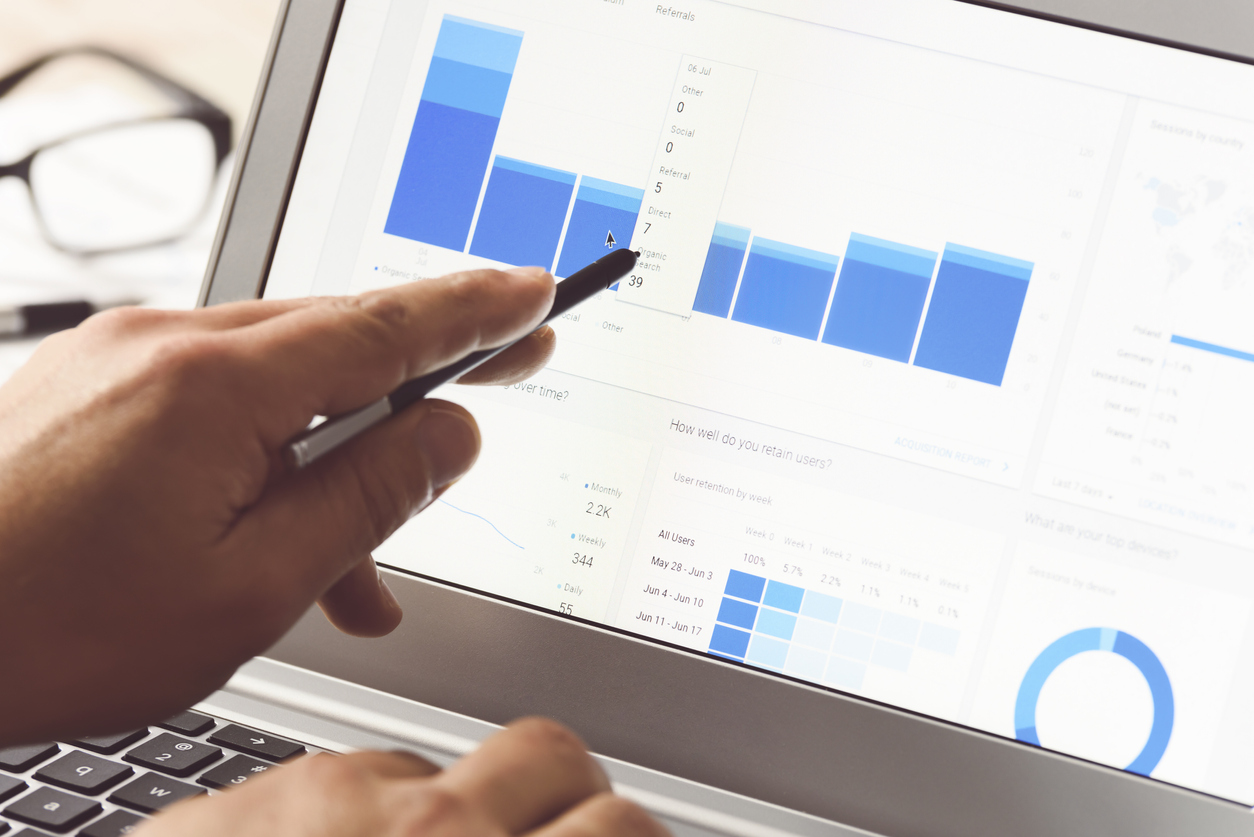
 STRATEGY CALL
STRATEGY CALL
These days small businesses rely heavily on effective marketing strategies to thrive in a competitive marketplace. To make informed decisions, it's crucial for these businesses to understand what is working and what's not when it comes to their marketing efforts. This is where Google Analytics 4 (GA4) comes into play. GA4 offers valuable insights into small business digital marketing analytics and performance. Our guide to Google Analytics 4 explains how the platform works and why it matters for small business growth.
It has powerful tools and features that allow local businesses to gain a deeper understanding of their marketing attribution and user
behaviour, and even predict customer trends. Let us guide you through the process of setting up custom events in GA4 and showcase its
predictive capabilities, allowing you to grow your knowledge of small business digital marketing analytics and performance. To learn more
about how to get started, contact us for a consultation.

Google Analytics 4 (GA4) is Google's current-generation analytics platform designed to provide more accurate, user-centric insights
across websites and apps. It replaces Universal Analytics and offers an event-based tracking model, allowing businesses to measure user
interactions with greater precision. This new platform helps marketers and business owners gain insights into how users interact with their
site or app and provides a clearer understanding of the entire customer journey. For small businesses, GA4 enables deeper analysis of
marketing performance, customer journeys, and conversion paths—all within a single reporting interface. It also includes machine learning
features that support forecasting and trend identification, helping guide data-driven decisions. Once you’ve set your analytics goals and
implemented the right tracking, these predictive tools can help guide strategic marketing decisions. They are especially valuable for small
business owners looking to improve marketing ROI and support long-term planning.
GA4 is used to track and analyze how users interact with your website and apps. You can use GA4 to review web analytics such as traffic,
engagement, and conversions. It helps businesses navigate the data, create a custom report, and even customize the dashboard for priorities.
For small businesses, GA4 supports decisions around campaign performance, audience behaviour, and sales attribution. It’s also used to set
up custom events, build audience segments, and generate reports that inform ongoing digital strategy.
Google Analytics 4 (GA4) and Universal Analytics (UA) differ significantly in how they collect and report data.
UA uses a session-based model, tracking user activity within a defined time period. GA4 uses an event-based model, capturing every
interaction—such as clicks, scrolls, and video plays—as individual events. This allows for more flexible and granular reporting in GA4.
GA4 is designed to track users across both websites and mobile apps within a single property. UA tracks each platform separately, making GA4
more suitable for businesses operating on multiple digital channels.
GA4 offers simplified, customizable reports and integrates machine learning to provide predictive metrics. UA relies on a broader set of
predefined reports with limited automation.
GA4 is built with privacy in mind, offering improved controls for data retention and consent. It’s designed to function without relying
heavily on cookies, aligning better with current data regulations. For small businesses, the move to GA4 ensures access to more actionable
insights and long-term compatibility with Google’s evolving analytics infrastructure.
Setting up Google Analytics 4 (GA4) is essential for collecting accurate data about how users interact with your website or app. Here's
how to get started:

If you don’t already have one, go to analytics.google.com and sign in with your Google account. Click Admin, then Create Account.
Under the Admin section, click Create Property. Enter your business name, set your reporting time zone and currency, and then choose GA4 as
the property type.
Choose Web as your data stream and enter your website URL. You’ll be given a Measurement ID. Use Google Tag Manager or add the gtag.js code
snippet directly to your site to begin tracking.
GA4 automatically tracks page views, scrolls, outbound clicks, and more. Leave enhanced measurement on for broader default tracking.
Add any custom events that align with your marketing goals—such as button clicks, form submissions, or video engagement. These can be
configured in Google Tag Manager or GA4 directly.
Mark your key events as conversions to track what matters most—such as lead submissions or completed checkouts.
Connect your GA4 property to Google Ads, Search Console, and BigQuery to consolidate insights across your platforms.
Google Analytics 4 (GA4) provides a powerful framework to track, analyze, and interpret how users engage with your website or app. Here’s
how to get started effectively:
Log in to your account and open your Google Analytics 4 property. The main dashboard gives you an overview of traffic, engagement, and
conversions. Use the search bar to quickly find metrics or reports.
From the left-hand menu, you can navigate to reports on acquisition, engagement, monetization, and retention. These sections provide
insights into how users interact with your site or app, showing the entire customer journey.
Use the template gallery to build new visualizations or customize reports to highlight KPIs important for your business. You can also create
a custom report to focus on specific campaigns or actions.
Track important user actions such as clicks, form submissions, or purchases. GA4 automatically captures basic events like page title and
screen name, but you can define additional ones. Mark critical events as conversions to better map the way to a conversion.
Leverage GA4’s predictive analytics powered by AI and machine learning to anticipate behaviors like purchase probability or churn. This
helps you see how many users are likely to return and plan your campaigns accordingly.
Link GA4 with other Google products such as Ads, Search Console, and BigQuery to unify your reporting. This makes it easier to measure
performance across various platforms and optimize your digital marketing.
Monitor active users, traffic sources, and queries driving visitors to your site. Use these insights to adjust strategies, strengthen content, and drive traffic more effectively.
GA4 is more than a replacement for Universal Analytics—it’s a new platform that helps marketers and business owners gain a clearer understanding of user behaviour and make informed, data-driven decisions.

Marketing attribution refers to the process of identifying the marketing channels and touchpoints that led to conversions and accomplishing your business goals. GA4 takes marketing attribution to the next level by providing a more holistic view of the customer journey. Unlike its predecessor, Universal Analytics (UA), GA4 incorporates both web and app data, enabling businesses to track user interactions across multiple platforms. This allows small businesses to gain a much more comprehensive understanding of their marketing efforts' effectiveness and optimize their strategies accordingly.
To gain more detailed information about user behaviour, custom events play a crucial role in GA4. Custom events allow businesses to track specific user actions, such as button clicks, form submissions, or video views, providing valuable insights beyond the standard pageview and session data. By setting up custom events, local businesses can measure the impact of their marketing campaigns more accurately.
Setting up custom events in GA4 is a straightforward process. First, define the specific user actions you want to track. Then, implement the necessary event tags on your website or app. GA4 provides an intuitive interface that guides you through the setup process, making it accessible to users with varying technical skills.
By leveraging custom events, business owners can answer critical questions about their small business's digital marketing analytics and
performance. Which buttons are most frequently clicked? How many users complete a contact form? Which posts have the highest engagement?
Armed with this information, SMBs can optimize their marketing efforts and improve their conversion rates by identifying and getting rid of
bottlenecks or friction points in the user journey.

GA4's predictive metrics offer an exciting opportunity for small businesses to stay ahead of the game. By analyzing historical data, GA4 can predict future customer behavior and trends, enabling businesses to make data-driven decisions and tailor their marketing strategies accordingly.
One of GA4's notable predictive metrics is the Churn Probability, which predicts the likelihood of a user ceasing their interactions with your business. Armed with this knowledge, small businesses can implement proactive retention strategies to engage and retain customers before they churn. By focusing on customer retention, businesses can optimize their marketing budget and maximize customer lifetime value.
Another valuable predictive metric is the purchase probability. This metric forecasts the likelihood of a user making a purchase in the future. With this information, small businesses can identify high-intent users and personalize their marketing efforts to boost conversions. For instance, you can create targeted email campaigns or offer exclusive discounts to users with a high purchase probability, increasing the chances of conversion.
GA4's predictive capabilities also allow you to predict revenue. With the revenue prediction metric, businesses can forecast their future
revenue based on historical patterns and trends. This empowers small businesses to set realistic revenue targets, allocate resources
effectively, and make informed financial decisions.

When it comes to small business digital marketing analytics and performance, GA4 is a game-changer. By providing an extensive view of marketing attribution, enabling custom event tracking, and offering predictive capabilities, GA4 arms local businesses with the knowledge they need to optimize their marketing efforts, attract more customers, and boost conversions. Implementing GA4 and leveraging its features can level the playing field for small businesses, helping them make data-driven decisions, anticipate customer behaviour, and stay ahead of the competition. With GA4, local businesses can unlock the true potential of their digital marketing analytics and drive their success in the digital landscape. This guide to Google Analytics 4 gives you the knowledge to use the platform effectively and apply it to your business goals. To learn more about small business digital marketing analytics and performance, get in touch with Smart WSI Marketing today.



